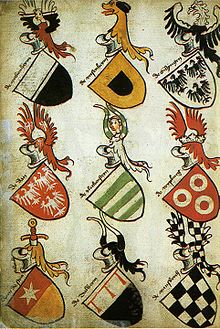
Back درعيات Arabic Heráldica AST Геральдика AV Heraldika Azerbaijani Геральдика Bashkir Геральдыка Byelorussian Геральдыка BE-X-OLD Хералдика Bulgarian Ardamezouriezh Breton Heraldika BS

Heraldry is a discipline relating to the design, display and study of armorial bearings (known as armory), as well as related disciplines, such as vexillology, together with the study of ceremony, rank and pedigree.[1][2] Armory, the best-known branch of heraldry, concerns the design and transmission of the heraldic achievement. The achievement, or armorial bearings usually includes a coat of arms on a shield, helmet and crest, together with any accompanying devices, such as supporters, badges, heraldic banners and mottoes.[3]
Although the use of various devices to signify individuals and groups goes back to antiquity, both the form and use of such devices varied widely, as the concept of regular, hereditary designs, constituting the distinguishing feature of heraldry, did not develop until the High Middle Ages.[4] It is often claimed that the use of helmets with face guards during this period made it difficult to recognize one's commanders in the field when large armies gathered together for extended periods, necessitating the development of heraldry as a symbolic language, but there is little support for this view.[4][5]
The perceived beauty and pageantry of heraldic designs allowed them to survive the gradual abandonment of armour on the battlefield during the seventeenth century. Heraldry has been described poetically as "the handmaid of history",[6] "the shorthand of history",[7] and "the floral border in the garden of history".[8] In modern times, individuals, public and private organizations, corporations, cities, towns, regions, and other entities use heraldry and its conventions to symbolize their heritage, achievements, and aspirations.[9]
- ^ Fox-Davies (1909), p. 1; Friar (1987), p. 183
- ^ Webster's Third New International Dictionary, C. & G. Merriam Company, Cambridge, Massachusetts (1960).
- ^ Fox-Davies (1909), pp. 1, 57–59
- ^ a b Fox-Davies (1909), pp. 1–18
- ^ John Brooke-Little, An Heraldic Alphabet, Macdonald, London (1973), p. 2.
- ^ Boutell (1890), p. 5
- ^ Fox-Davies (1909), p. v
- ^ Iain Moncreiffe of that Ilk & Pottinger, Simple Heraldry, Thomas Nelson (1953).
- ^ Fox-Davies (1909), pp. 19–26